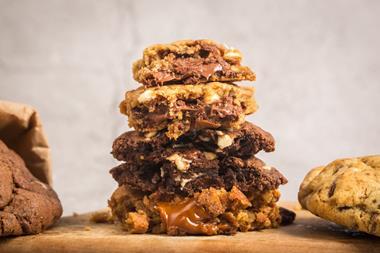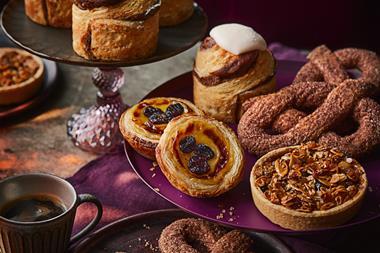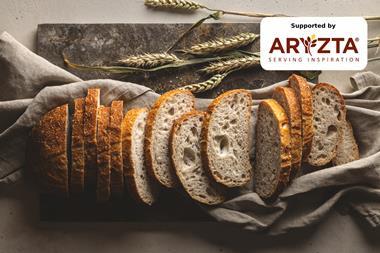As consumers’ appetite for artisan-style baked goods continues to grow, German, Nordic and Eastern European breads offer big opportunities.
By the time you read this, Britain will, hopefully, have a clearer strategy for exiting the EU. And regardless of politics, it’s a safe bet that whatever happens on 29 March, UK consumers will still want breads inspired by our European neighbours.
The humble baguette, for example, is the UK’s third most popular savoury bakery item, according to Lantmännen Unibake UK, with Brits buying 85 million a year.
Of course, European bakery has far more to offer than baguettes, ciabattas and paninis, and there are big opportunities to be found just slightly further afield.
Folded flatbreads based on Italian mezzaluna or piadina have become a success in retail and quick-serve restaurants, says Tim Wittekind, head of NPD at Signature Flatbreads.
Signature has developed a sliced focaccia flatbread under its Deli Kitchen range and, last month, rolled out a Deli Kitchen brioche folded flatbread exclusively in Sainsbury’s.
Brioche Pasquier, which has helped establish brioche in the UK, feels there is an opportunity to develop a market for another French speciality – biscotte.
Made from French bread baked twice to give a crunchy texture, it is similar to Italian biscotti but has a plain, natural flavour.
“We make a variety of shapes and sizes suited to different uses – dipping, as a base for canapés or as an accompaniment to cheese boards,” says Brioche Pasquier foodservice sales manager Jon Turonnet.
Other French bread varieties such as fougasse, a flat white loaf cut to resemble an ear of wheat, could find a larger UK audience, suggests Tina Glen, product development manager at frozen baked goods supplier Pan’Artisan.
Many in the industry view German, Nordic and Eastern European breads – often rye-based – as a huge opportunity.
“The mainstream adoption of good sourdough has inspired consumers to look closer at other alternative flours and bread varieties,” says Stéphanie Brillouet, marketing director for Northern Europe & North America at Délifrance.
The popularity of a more rustic style is driving the company’s bread NPD, particularly following its recent
acquisition of German bakery business Heinz KG.
“We’ve incorporated their expertise in rustic, hand-shaped products into our NPD to meet our customers’ need for a wider range of artisan-style breads.”
Danish bakery Ole & Steen, which made its debut in the UK four years ago, is starting to see a rise in the popularity of its rye breads, but believes there is still a way to go as it is a more substantial, denser bread than the UK palate is traditionally used to.
“We’re now looking at introducing a wheat and rye bread into the mix,” adds Mads Brinks, the bakery’s director of brand experience. “It will still have the depth of flavour a rye should have, but it’ll be a bit lighter in texture.”
Rye is already making inroads in the UK, of course.
“Rye breads have made their way into many London bakeries, both sold by the loaf and as a carrier, providing consumers with alternative lunchtime meal experiences,” says Michael Schofield, marketing manager at Bakels, which produces a rye bread concentrate.
Citing Mintel data, Edme sales director Mike Carr says rye bread launches in Britain increased 31% from 2015 to 2018.
“Eastern European breads and sourdoughs tend to vary from country to country, but often feature rye flour and rye bran, barley and pumpernickel, as well as strong white wheat flours,” says Tasneem Alonzo, joint managing director at EHL
Promoting health cues
Appearance and taste are big drivers of interest in European artisan-style bread – but demand could be further boosted by ramping up the health cues around products.
For example, with some European-style breads produced using refined white flour, it is possible to develop ‘better-for-you’ versions, suggests Edme sales director Mike Carr.
“These can retain the authenticity and appeal of the original styles, but provide more nutritional and health benefits,” he explains.
“Baguettes, for example, are traditionally created using hard-wheat, plain white flour, and bagels with high-protein, strong white flour. By adding a percentage of malted flours, pulse flours, kibbles or flakes, bakers can nudge consumers towards healthier eating.”
Carr says malted flakes, for example, are a natural source of fibre, and are also high in vitamins such as B6 and C, and minerals such as iron and riboflavin.
“They can be used as inclusions or toppings, and in addition to boosting nutrition, they increase the visual, textural and taste appeal of the products.
Inclusions are expected to play a big role in wellness-focused breads in the coming years, according to Délifrance, which has expanded its Héritage range with indulgent rolls topped with flax, oatmeal and pumpkin seeds.
“We’ve also added to our Feel Good range, with ‘superfood’ inclusions like our chai & cranberry, and beetroot & seeds half-baguettes,” adds marketing director Stéphanie Brillouet.
Food-to-go consumers are increasingly demanding ‘healthier’ products,” says Bridor baker Jon Warwick.
“We have also seen this change occurring with a steady move towards cereal products, ancient grains, ryes and Scandinavian carriers. We believe this part of the market will continue to increase rapidly.”
The burgeoning free-from category is also a potential avenue for development.
“Bakers who manage to reproduce European styles of bread using gluten-free flours will find they are knocking at an open door with consumers,” says Carr.
Speciality bread winner
Artisan baker Alex Gooch won the Speciality Bread Product of the Year category in the 2018 Baking Industry Awards with this Slow Roast Tomato, Olive & Marjoram Ciabatta.
Made by Gooch at his bakery in Hay-on-Wye, it contains all organic ingredients, mostly grown locally, comprising wheat flour, rye flour, local organic tomatoes (in season), Greek olives, local wet garlic, local marjoram, extra virgin Sicilian olive oil, sea salt and yeast.
The dough is fermented for more than 18 hours, and the tomatoes are slow-roasted with garlic and sea salt for
24 hours.
“We wanted to aim for great character and flavour as well as really good, natural and wholesome ingredients,” explains Gooch. “We also include some British heritage flours. Quality is everything to us.”


























No comments yet